Chidambaram to most North Indians is just the name of a famous politician. Maybe it is the name of the village he comes from. It is only when you come down south or when you study temples in South India that you know that Chidambaram is home to the famous Nataraja Temple also called Chidambaram Temple. Located about 240 odd km south of Chennai and 60 km south of Pondicherry this town has many big and small temples to visit.
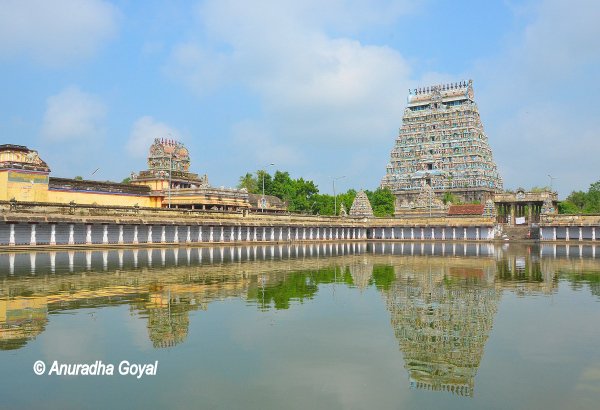
History & Legend of Nataraja Temple
Long before the temple came up, this place used to be a huge forest called Thillai Vana named after Thillai mangroves. Rishis used to live here and perform rituals. They started believing that Shiva can be controlled by powerful mantras. So, Shiva one day decided to visit them garbed as a wandering mendicant, accompanied by Vishnu in the form of Mohini. Wives of the rishis were enchanted by Shiva, so Rishis threw serpents on him. He simply accepts them and wears them as his ornaments.
They throw a tiger at him & Shiva kills it and wears its skin around his waist. Sages then pool in all their spiritual powers and invoke the Muyalakan Asura – a symbol of ignorance and arrogance. Shiva simply stands on it making it immobile. He then performs Anand Tandava – the dance of bliss and reveals his true form to the Rishis. They all bow down to him and realize their ignorance.
Anand Tandava
Another legend says that Vishnu as Adi Shesha came here to witness the Anand Tandava of Shiva. He continues to be present at the temple as Govindaraja.
Since then, Shiva is known and worshiped here in the same form.

Historical references to this Thillai Nataraja temple indicate that it has been in practice since at least 6th CE. The Sangam literature refers to Viduvelvidugu Perumtaccan, a clan of the traditional Vishwakarma community, as the chief architect of the temple renovation. The poetry of Appar and Sambadar talks about the dancing lord of Chidamabaram. Chidambaram was the capital of Cholas around 10th CE, before moving to Thanjavur, and Nataraja their Kul Devta.
Read More – Brihadeeswara Temple, Thanjavur
However, material evidence exists from the 12th CE onwards. Various dynasties of the South Indian rulers like Pallavas, Pandyas, Cholas, Cheras, and Vijaynagara Kings have contributed to the expansion and maintenance of this temple during their respective periods. You can find imprints of them in various parts of the temple.
The temple was attacked by Malik Kafur in the early 14th CE when he took back a lot of temple wealth. A lot of Murtis were buried underground and have been excavated lately. Portuguese, British and French times were not kind to the temple.
Forms of Shiva at Nataraja Temple
The primary form of Shiva worshipped in this temple is Nataraja – the king of Dance, the cosmic dancer. The dance poses can be seen on the Eastern Gopuram of the temple. Technically, they are not just dance poses, but 108 Karanas or movements that are used in this classical dance.
Read More – Understanding the Iconography of Nataraja
He is also present in his more popular form as Lingam.

Chidambaram Rahasya – Chidambaram Temple is also one of the 5 Panchbhootam temples in South India. It represents the Sky or Akash element of the primary elements. The sanctum has an empty space marked by a garland of 51 golden Bilva leaves that is worshipped. It is believed that Shiva and Parvati live here but they are not visible to the human eyes. The place is always covered with red and black cloth curtains representing Maya. It is only opened during special Pujas when you can see the golden Bilva leaves. This makes this temple absolutely unique.
Other Panch Bhootam temples include – Ekambareshwar Temple at Kanchipuram representing Prithvi or Earth, Jambukeshwarar Temple at Trichy representing Apa or Water, Arunachaleshwar Temple at Thiruvannamalai representing Agni or Fire and Kalahasteeshwarar Temple at Kalahasti representing Vayu or Air element.
Daily Puja & Festivals at Chidambaram Temple
The daily Puja begins by bringing the Padukas or the footwear of the deity in a palanquin. There are 6 different pujas that are performed throughout the day. All these Pujas involve an Abhishek of the Lingam. The day closes with Padukas going back to the palanquin.
Two important festivals of the temple are Marghazhi Thiruvaadhirai and Aani Thirumanjanam. Deities step out of the sanctum and go on a procession in chariots or temple cars.
Nataraja Temple is managed by a community of Dikshitar Brahmins who inherit the position of Archaka from their families as soon as they are married. It is believed that Patanjali brought them here from Kailash Parvat, though they look more like Kerala Namboodris.
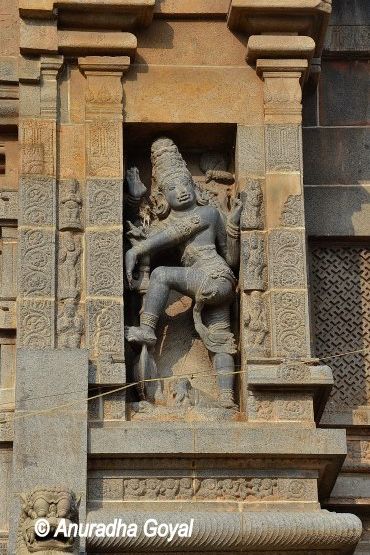
Temple Architecture
The temple complex is spread across 40 acres of land and is surrounded by 5 layers of Prakaras or courtyards, the innermost being the sanctum. The temple follows the typical Dravidian architecture. The sanctum however is in typical Kerala or Malabar style.
Gopurams
Four huge Gopurams flank the four cardinal directions of temples on the outermost Prakara, of the total of nine gopurams that surround the temple. These Gopurams are far higher than the temple itself which is of modest height but is compensated by the fact that the roof is pure gold. The main entrance is from the East gopuram through a narrow street that has vendors selling pooja items and stands to hold your footwear. The gopuram is not painted till the gateway. The superstructure is painted in multi-color with blue forming a background and various Gods and Goddesses depicted with their identifiable features telling stories from the scriptures.

The inner walls of this Gopuram have all the Bharatnatyam poses carved in small square stone tiles. On the front and back of the gopuram, there are small statues. Some of them are locked and I could not get an answer as to why that has been done.
Mahishasuramardini
Some Murtis are clothed and decorated with flowers and it appears they are worshiped while others are probably just admired. I think Mahishasuramardini figures, of the Goddess, killing the demon Mahishasur, were the ones that seem to be worshiped wherever they appear in the sculptures. There is a curious sculpture of a bearded smiling man with folded hands. My best guess is that it depicts one of the kings who patronized this temple at some point in time. His consort seems to be in the smaller niche by his side. Other Gopurams are also similar to an untrained eye, though the dance poses are not there. There are some big and small temples in the courtyard belonging to various deities.
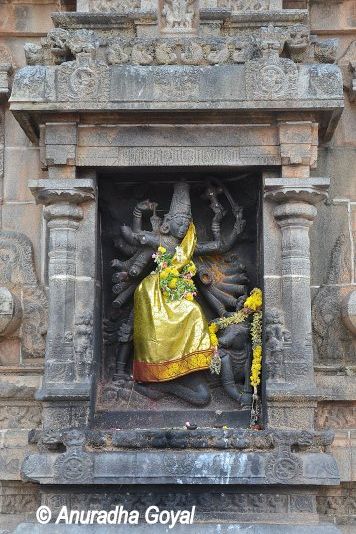
Shiva Temple
Inside the temple are huge corridors supported by huge rectangular pillars with a protruding top creating a canopy over the corridors. Pillars are mostly plain but the top parts are carved. Walking through these corridors can make you feel majestic. As the inner part of the temple is kind of cut from the outside, it transports you to a different world and probably a different time. There were not too many people at the time I was there. But whoever was there wore traditional clothes and was in their devotional state, adding to the ambiance.
There are Pandits with their half-shaved heads and the rest of their hair in a knot and various dots and lines as stamps of their jobs. They keep an eye on the visitors and try to engage them for Poojas and suddenly lose interest in them when they say no.
Sanctum
Sanctum or the Garbha Griha of Nataraja Temple is also known as Chiti Sabha or the Hall of Consciousness. It is a rectangular wooden structure on a granite base with a gilded and unusually slanting roof – quite a unique architecture. Garbhgriha houses the Nataraja Murti and is approached from the side rather than the front. You can hardly see the idol or statue as it is covered in so many layers of clothes and flowers. All you get to spend there is a couple of minutes.
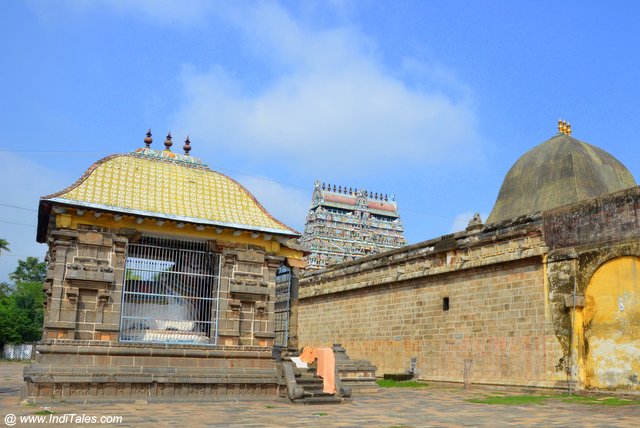
In fact, the name Chidambaram is derived from Chit + Amabram meaning the Sky of Consciousness, both of which are represented in the sanctum of this temple.
Golden Hall
Kanak Sabha or the golden hall stands bang opposite the Chiiti Sabha with a golden roof. It is said that it is made of 22,600 tiles fixed with 72,000 golden nails. 22,600 is the number of breaths we take in a day and 72,000 is the number of nerves in a human body. 9 pots or Kalashas on top indicate the 9 doorways in a human body. It is used for performing many rituals and also for getting the darshan of the main deity. These two structures are at the core of this temple, everything else surrounds them.
Nritta Sabha or a Dancing Hall with 56 pillars is designed in the shape of a chariot with horses and wheels. It is believed to be the place where Shiva and Kali danced and Shiva won with his famous Urdhava Tandava pose.
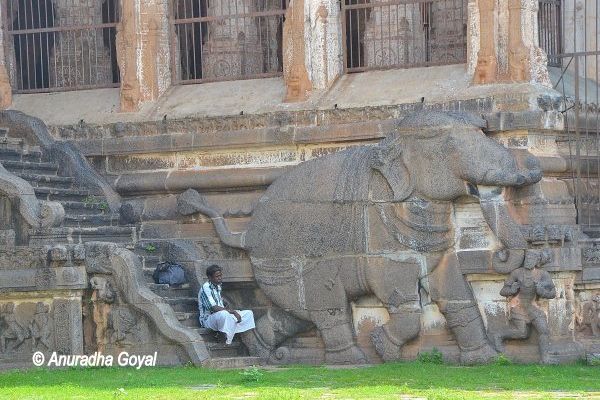
Raja Sabha or the 1000 pillared hall is located close to the Shiva Ganga tank. One can imagine pilgrims sitting here near the cool waters to take some rest. It has a giant elephant sculpture carved on its walls. It kind of looks abandoned.
Dev Sabha – Hall of Deities is one of the older structures. It was probably used by visiting saints to sing.
Other Temples in the complex
Shivakamasundari Temple – The Main Shakti Shrine in the complex dedicated to Parvati. Originally, this temple had the whole of Devi Mahatmayam painted, which is lost over time. Situated at the back of the main temple, it has colorful floors.

Govindaraja Temple is dedicated to reclining Vishnu – it is among the 108 Divya Desams of Vishnu. I was pleasantly surprised to a sleeping Vishnu and Lakshmi at the Shiva temple when Shaivites – Vaishnavites disputes are so well known in this region. There could not be a better example of inclusivity in religion.
- Chandikeshwara Temple is found in every south Indian Shiva temple
- Mahalakshmi Temple
- Moolstahan where Shiva is worshipped as Linga
- Subramanya Temple
- Ganesha Temple
- Sundresvara and Minakshi Temple
- Navagraha Temple
- Surya or Sun Temple is among the oldest parts of this temple.
- Nine Linga Temple
Shivaganga Tirtha is the main temple tank though there are many water bodies within the temple complex. It is a decent-sized Pushkarni on the side of the temple along the northern Gopuram. The reflection of the gopurams in the water looks beautiful. A pillared corridor goes along the Pushkarni but it was filthy when I visited it. You would think many times before putting your foot there.
Kalyan Mandapa & a Yagna Shala
The interior of this temple is huge and you can spend quite some time walking around it. There are smaller shrines on one side. In places, you can see ceiling paintings in bright blue and golden yellow. The main shrine has a curvilinear roof in gold and doors in silver.
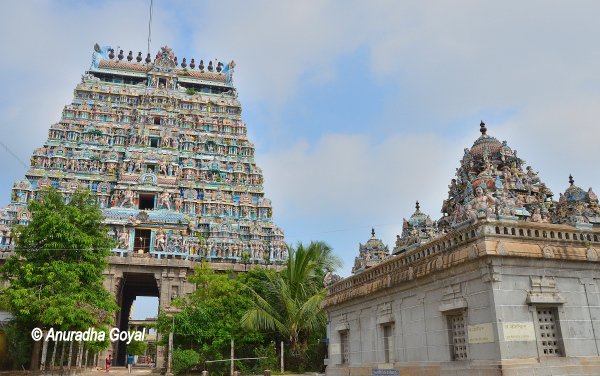
Elephant sculpture on 1000 Pillar Hall Mandapa
Upkeep of the premises
Rusting on the walls probably shows the iron content in the stone. Is that why the gopurams are painted to keep them free of rust and the region is humid most of the time? Electrical fittings in the temple definitely need some design inputs. As of now, they seem to have been put as if they are there to deflect the evil eye. There are some hints of paintings here and there. I wonder if any effort was ever done to preserve them. You seriously wish that this kind of heritage, as well as a devotional place, is kept clean in the first place. This, however, does not seem to bother the devotees or the authorities.
Travel Tips
- You can easily spend half a day in this temple itself, admiring its sculptures, its architecture, and observing the living traditions of this place.
- Definitely keep 1-2 hours to walk around the temple.
- Temple is open from morning to evening but it closes between Noon to 5:00 PM. For more details check the temple website.
- Photography is allowed outside the temple but not inside the temple, and definitely not close to the sanctum.
There is a lot to see in Chidambaram beyond this iconic temple. Do explore the city.






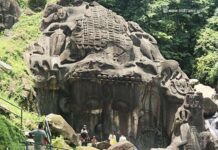
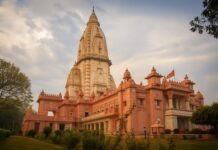






Wonderful post on Nataraja temple. Loved that elephant architecture.
hi,
Excellent Blog!! That was awesome. Your believed handling is amazing. The way you tell the factor is awesome.
Anu, typically, you will find Vishnu in a Shiva temple, but not the other way around. Only pure Saivites, as one might encounter in Sri Lanka – or Hawaii — keep Vishnu out.
Very nice temple. Need to visit there next time…
I blog
Very nice temple i was visited in 2010. planing to visit but let’s see when i get free from then defiantly i will visit one more time.
i have visited this temple in 2010 planing to visit next year when i get free from work hope my work get over soon .
Beautiful temple. Amazing pics.
Thank you Rupam. It is a lovely temple.